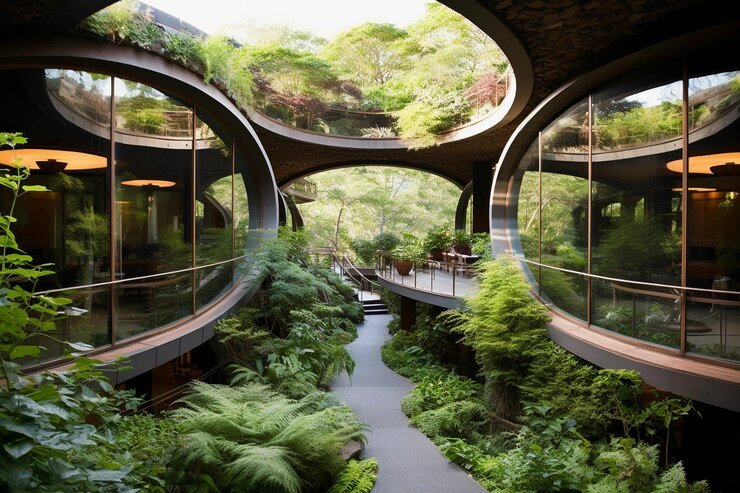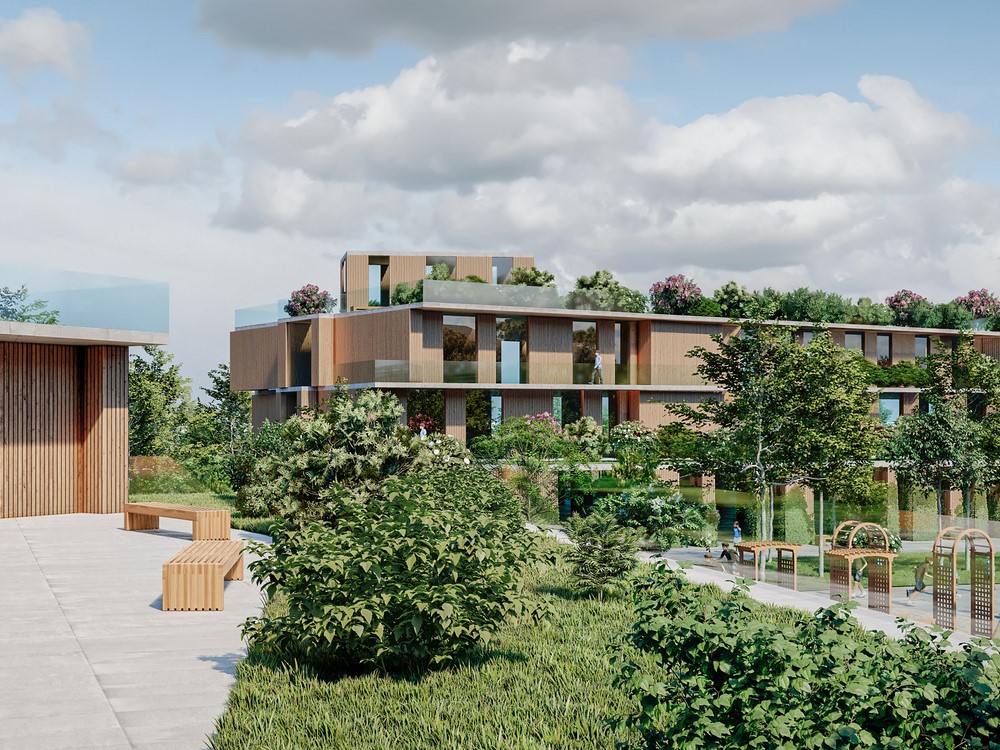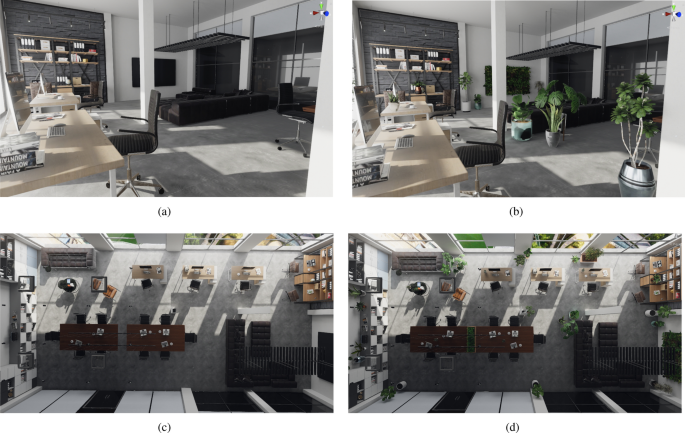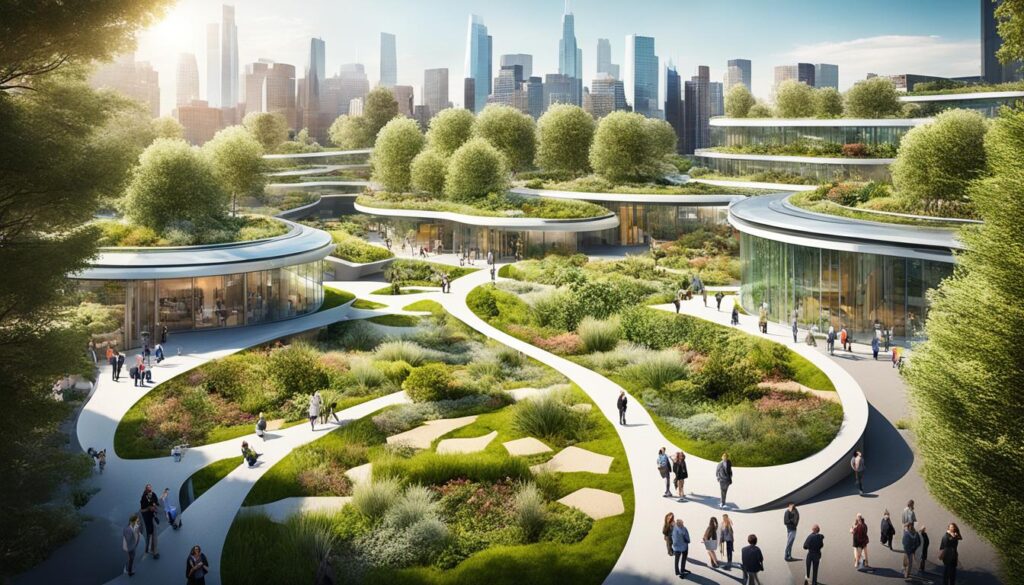Technological Innovations in Biophilic Architecture.
In an increasingly urbanized world, the integration of nature and technology in architecture has become paramount. Biophilic architecture, a form of sustainable design, embodies this concept by bringing the outdoors into our living and working environments, thereby enhancing their quality and contributing to urban resilience.
The incorporation of innovative technologies such as smart lighting systems, automated climate control, and living green features not only promotes well-being but also addresses critical environmental challenges. This exploration examines how these technological innovations, including the integration of indoor gardens and natural ventilation, contribute to health and productivity while also considering the challenges they may pose.
We invite you to engage with us in uncovering the future of biophilic architecture and the technology, including smart technology and artificial intelligence, that is propelling its evolution.
What Is Biophilic Architecture?
.jpg_00.jpeg)
Biophilic architecture represents an innovative design approach that aims to integrate natural elements within the built environment, thereby fostering a connection between humans and nature to enhance overall well-being. This approach incorporates nature-based solutions and wellness architecture to create user-centric spaces.
This design philosophy encompasses principles of sustainability, environmental psychology, and urban ecology, all with the objective of reducing the ecological footprint of buildings while maximizing comfort, resilience in architecture, and aesthetic appeal.
By incorporating biophilic design elements such as natural light, water features, and living walls, architects leverage both passive design and active smart homes technology to create restorative environments that promote health and wellness in both residential and commercial settings.
How Does Biophilic Architecture Incorporate Technology?
Biophilic architecture effectively incorporates advanced technological innovations to strengthen the connection between occupants and the natural environment, resulting in smart buildings that prioritize energy efficiency, user engagement, and enhanced building performance.
By utilizing biophilic technologies such as the Internet of Things (IoT) in architectural design, professionals can monitor and optimize indoor air quality, natural light, and thermal comfort, thereby ensuring that spaces are responsive to the needs of their inhabitants and improve environmental sustainability.
The integration of features such as automated temperature control, smart lighting systems, and environmental monitoring facilitates an immersive experience that not only celebrates nature but also promotes sustainability.
1. Smart Lighting Systems
Smart lighting systems are essential components of biophilic architecture, as they effectively mimic natural light patterns to promote health and wellness within indoor environments. By employing sensors and automated controls, these systems adjust lighting levels according to the time of day, thereby enhancing the connection to the external environment while simultaneously improving energy efficiency.
This dynamic approach not only brightens indoor spaces but also significantly contributes to fostering a sense of well-being among occupants. As natural daylight changes throughout the day, these intelligent systems adjust color temperature and intensity to closely replicate the sun’s trajectory, which has been shown to enhance productivity and elevate mood.
Research has demonstrated that exposure to simulated natural light can lead to improved cognitive function and reduced fatigue, creating a more invigorating atmosphere conducive to both work and relaxation. Furthermore, these systems align seamlessly with human circadian rhythms, thereby supporting better sleep patterns and overall health through the regulation of melatonin levels.
In conclusion, smart lighting systems within biophilic design serve a purpose beyond mere illumination; they rejuvenate the spirit and harmonize indoor experiences with the natural world.
2. Automated Temperature Control
Automated temperature control systems in biophilic architecture significantly enhance thermal comfort by dynamically adjusting to the occupants’ needs and environmental changes. These systems not only improve the user experience but also contribute to energy efficiency by optimizing heating and cooling based on real-time data.
By employing advanced sensors and algorithms, these systems effectively monitor ambient conditions alongside individual preferences, facilitating a responsive approach to climate management. When temperatures fluctuate or a room becomes occupied, the system automatically recalibrates, ensuring that the environment remains comfortable and inviting.
This level of automation is instrumental in reducing energy consumption by minimizing unnecessary heating or cooling, which can result in lower utility expenses and a reduced carbon footprint. Ultimately, this technology not only supports sustainable building practices but also fosters a healthier indoor atmosphere, exemplifying the harmonious relationship between occupants and their surroundings.
3. Living Walls and Green Roofs
Living walls and green roofs are vital biophilic elements that integrate nature into urban environments, thereby fostering biodiversity and enhancing ecological design. These green installations not only improve aesthetic appeal but also provide insulation, enhance air quality, and mitigate the effects of urban heat while supporting urban ecosystems and ecological restoration.
By incorporating a variety of plant species, these structures create habitats for pollinators and other wildlife, promoting a dynamic ecosystem within city limits. For example, rooftop gardens in cities such as Toronto and New York have transformed previously barren areas into vibrant retreats, significantly increasing populations of insects and birds and promoting urban biodiversity.
These features contribute to ecological sustainability by reducing rainfall runoff and lowering energy consumption; green roofs can diminish the need for air conditioning by maintaining cooler temperatures within buildings during the summer.
As urban planners increasingly acknowledge the multifaceted benefits of these installations, they are becoming integral to the design of sustainable cities.
4. Virtual Reality and Augmented Reality
Virtual reality (VR) and augmented reality (AR) technologies provide immersive environments that significantly enhance the user experience in biophilic architecture by creating engaging and interactive spaces. These technologies enable users to visualize natural elements, such as landscapes and water features, within built environments, thereby fostering a stronger connection to nature and enhancing sensory experiences.
By integrating these innovative tools, architects and designers can develop virtual walkthroughs that allow users to explore various configurations of greenery and natural light prior to actual construction.
For instance, AR applications enable individuals to use their devices to visualize how different plant species would thrive in a given space, thereby enhancing both aesthetic appeal and emotional well-being.
Moreover, VR can simulate seasonal changes, allowing inhabitants to experience the transformation of their environment throughout the year. This application not only promotes a deeper appreciation for nature but also encourages environmental stewardship, positioning biophilic architecture as not merely a design trend, but rather as a restorative approach to urban living through innovative construction methods.
What Are the Benefits of Technological Innovations in Biophilic Architecture?
.jpg_01.jpeg)
Technological advancements in biophilic architecture offer a range of benefits that significantly enhance the health and wellness of occupants, while also promoting sustainability and energy efficiency through the use of eco-friendly materials and energy-positive buildings.
The integration of smart systems alongside biophilic design principles leads to improvements in productivity, comfort, and spatial quality, as well as a reduction in environmental impact.
These innovations play a crucial role in fostering climate-responsive design and enhancing urban resilience in diverse settings.
1. Improved Health and Well-being
Biophilic design has been demonstrated to significantly enhance health and well-being through the incorporation of natural elements into built environments. This integration, supported by the principles of environmental psychology, fosters mental clarity, reduces stress, and promotes a sense of connection to the natural world, contributing to the health benefits of occupants.
Numerous studies have underscored the benefits of access to natural light, greenery, and water features, which can lead to improved physical health outcomes. For example, a case study conducted in office environments indicated that employees with views of green landscapes reported up to 15% higher job satisfaction and experienced fewer sick days, highlighting the role of nature-connectedness.
Research further suggests that exposure to nature-based environments can result in lowered blood pressure and improved cardiovascular health.
By fundamentally reimagining the design of spaces, biophilic design not only enhances aesthetic appeal but also establishes a holistic environment that supports improved mental and physical health.
2. Increased Productivity and Creativity
Incorporating nature-inspired design elements within workspaces significantly enhances productivity, creativity, and overall user experience among occupants.
Such designs frequently feature large windows that provide expansive views of the outdoors, green walls adorned with a variety of plants, and the use of natural materials such as wood and stone. These elements collectively create an environment that promotes tranquility, supports climate adaptation, and stimulates the generation of new ideas.
For example, a technology firm that implemented a rooftop garden observed a substantial increase in employee satisfaction and collaboration, as team members engaged in brainstorming sessions amidst the greenery, emphasizing the importance of creative placemaking and community engagement.
These biophilic designs do not merely enhance the aesthetic appeal of a space; they also contribute to cognitive benefits, demonstrating that immersion in nature can improve focus, promote social equity, and encourage innovative problem-solving.
Consequently, workplaces that adopt these design elements can experience transformative changes, not only in productivity levels but also in the overall workplace culture, enhancing indoor air quality and promoting wellness architecture.
3. Energy Efficiency
Energy efficiency serves as a fundamental principle in biophilic architecture, achieved through the implementation of passive design strategies and the utilization of renewable materials. By maximizing the use of natural light, incorporating smart technology, and optimizing building orientation, these designs significantly reduce energy consumption while enhancing occupant comfort.
For instance, the use of thermally efficient windows, strategic landscape integration, and indoor gardens can effectively regulate indoor temperatures, thereby minimizing the reliance on artificial heating and cooling systems.
Projects such as the Bosco Verticale in Milan exemplify this concept, as the integration of vegetation not only enhances air quality but also provides natural insulation, contributing to urban biodiversity.
Additionally, employing sustainable materials, such as reclaimed wood or recycled metals, reflects a commitment to both energy efficiency and environmental stewardship through the use of eco-friendly materials.
Through the incorporation of these methods, biophilic architecture not only promotes occupant well-being but also contributes to the development of more sustainable and energy-efficient buildings, enhancing overall building performance.
4. Reduction of Urban Heat Island Effect
Biophilic architecture plays a crucial role in mitigating the urban heat island effect through the implementation of green building practices and landscape architecture that fosters biodiversity. Features such as green roofs and living walls are effective in reducing heat retention in urban areas, thereby contributing to a more sustainable and comfortable living environment and promoting urban resilience.
By integrating natural elements, including trees and plants, into building designs, this architectural approach effectively lowers surrounding temperatures, thus enhancing urban habitats. Such designs not only improve air quality but also promote wildlife corridors, contributing to a healthier ecosystem.
The use of reflective materials and the optimization of building orientation further assist in minimizing heat absorption, demonstrating that thoughtful architectural design can address the environmental challenges posed by urbanization while improving thermal comfort.
As cities continue to expand, the adoption of biophilic strategies not only enhances resilience against climate change but also enriches the quality of life for urban inhabitants by fostering a connection with nature.
What Are the Challenges of Implementing Technological Innovations in Biophilic Architecture?
Technological innovations in biophilic architecture provide considerable advantages; however, they also pose challenges that must be addressed to ensure successful implementation.
High initial costs, ongoing maintenance requirements, and the limited availability of advanced technologies can impede the widespread adoption of these innovative solutions within the realm of sustainable architecture.
High initial costs, ongoing maintenance requirements, and the limited availability of advanced technologies can impede the widespread adoption of these innovative solutions within the realm of sustainable architecture.
Moreover, integrating augmented reality and virtual reality into these designs can create immersive experiences, though it also adds to the complexity and cost of implementation.
Technological innovations in biophilic architecture provide considerable advantages; however, they also pose challenges that must be addressed to ensure successful implementation.
High initial costs, ongoing maintenance requirements, and the limited availability of advanced technologies can impede the widespread adoption of these innovative solutions within the realm of sustainable architecture.
1. High Initial Costs
.jpg_10.jpeg)
One of the primary challenges in adopting technological innovations in biophilic architecture is the substantial initial costs associated with advanced systems and materials. These financial barriers can deter stakeholders from investing in sustainable architecture and implementing biophilic design principles, including nature-based solutions and ecological design.
Exploring various funding sources and financial incentives can significantly alleviate these costs. Government grants and subsidies aimed at promoting green building initiatives are often available for projects that integrate sustainable technologies.
Additionally, private sector funding, such as impact investments and green bonds, may support innovative designs that promote environmental stewardship. Tax credits and rebates for energy-efficient installations can also reduce the financial burden, making it more feasible for developers and architects to incorporate cutting-edge technology within biophilic structures, contributing to overall architectural sustainability.
By leveraging these resources, stakeholders can transform initial investments into long-term savings and enhanced property value.
2. Maintenance and Upkeep
The maintenance and upkeep of advanced technological systems in biophilic architecture represent a significant challenge that impacts the longevity and operational costs of these installations. Regular maintenance is essential to ensure that these systems operate optimally and continue to deliver health and environmental benefits.
Neglecting this critical aspect can result in reduced efficiency, increased energy consumption, and ultimately undermine the intended impact of the biophilic design.
To effectively preserve these innovations, it is advisable to implement best practices, including:
- Routine inspections
- Timely repairs
- Ensuring that all components—such as HVAC systems, lighting, and water features—are serviced on a regular basis
Utilizing technological solutions, such as building information modeling (BIM) and monitoring systems, can assist in identifying potential issues before they escalate. Additionally, providing proper training for employees regarding system usage and maintenance can further enhance sustainability efforts.
These strategies not only protect the investment but also contribute to the development of healthier and more productive living environments.
3. Limited Availability of Technology
The limited availability of advanced technologies essential for biophilic architecture can impede progress and adoption across various markets. As the demand for sustainable solutions continues to rise, it becomes increasingly critical to ensure that innovative technologies are accessible and widely available, facilitating climate-responsive design and ecological restoration.
In numerous regions, the costs and complexities associated with implementing these technologies can pose significant barriers to entry. This situation adversely affects not only architects and builders but also stifles overall market innovation in sustainability practices.
To address this challenge, efforts should be directed toward promoting collaboration among stakeholders, including local governments and technology developers, with the aim of reducing costs through shared resources and knowledge, thereby enhancing urban planning and integration of technology.
Educational initiatives could play a vital role in raising awareness and generating greater market interest in biophilic solutions.
By cultivating a community that prioritizes sustainability, increased accessibility can be achieved, potentially leading to higher demand and further technological advancements.
What Does the Future Hold for Biophilic Architecture and Technology?
The future of biophilic architecture and technology appears highly promising, propelled by advancements in sustainable technology and the integration of artificial intelligence.
As the urgency for climate action intensifies, architects and designers are diligently exploring innovative solutions that enhance the relationship between built environments and nature, while simultaneously promoting sustainability.
As the urgency for climate action intensifies, architects and designers are diligently exploring innovative solutions that enhance the relationship between built environments and nature, while simultaneously promoting sustainability and environmental impact.
The future of biophilic architecture and technology appears highly promising, propelled by advancements in sustainable technology and the integration of artificial intelligence.
As the urgency for climate action intensifies, architects and designers are diligently exploring innovative solutions that enhance the relationship between built environments and nature, while simultaneously promoting sustainability.
1. Integration of Artificial Intelligence
The integration of artificial intelligence into biophilic architecture has the potential to transform smart buildings by optimizing energy management and enhancing the user experience. AI-driven systems can analyze occupancy patterns and environmental data to create adaptive and responsive environments that prioritize sustainability and occupant well-being, contributing to overall building performance and operational efficiency.
By utilizing machine learning algorithms, these systems can forecast energy requirements based on real-time usage and weather conditions, resulting in substantial reductions in energy consumption. For example, automated shading systems can adjust in response to sunlight intensity, thereby minimizing the reliance on artificial lighting and cooling.
Furthermore, AI tools can personalize user experiences by tailoring indoor environments to individual preferences, which promotes a greater sense of comfort and connection to nature. This fusion of technology and biophilic design not only encourages energy efficiency but also fosters increased engagement with the surrounding environment, ultimately enhancing the overall quality of life for occupants.
2. Advancements in Sustainable Technology
Advancements in sustainable technology are facilitating the development of innovative biophilic architecture solutions that employ renewable materials and strive for energy-neutral buildings. These technologies play a crucial role in creating built environments that are ecologically responsible while also enhancing occupant comfort and satisfaction.
The integration of smart systems and environmentally friendly materials allows architects to design spaces that establish a seamless connection with nature while minimizing the ecological footprint and promoting ecological design.
Innovations such as solar panels, rainwater harvesting systems, and sustainably sourced timber contribute not only to reduced energy consumption but also to the promotion of a healthier living environment. As these practices gain traction, they reflect a significant commitment to sustainability and well-being, inspiring a new generation of designs that harmonize human habitation with the natural world.
Ultimately, the pursuit of energy neutrality in these structures represents a pivotal shift towards sustainable living, benefiting both individuals and the planet, and demonstrating resilience in architecture.
3. Increased Accessibility and Affordability
.jpg_11.jpeg)
The increased accessibility and affordability of biophilic design elements are critical for promoting widespread adoption and facilitating market growth. As more stakeholders acknowledge the significance of integrating natural elements into architecture, efforts to democratize access to biophilic innovations will foster positive advancements in building practices.
These efforts will also contribute to social equity and the development of user-centric spaces that promote health and wellbeing.
The increased accessibility and affordability of biophilic design elements are critical for promoting widespread adoption and facilitating market growth. As more stakeholders acknowledge the significance of integrating natural elements into architecture, efforts to democratize access to biophilic innovations will foster positive advancements in building practices.
This approach not only extends the reach of such designs beyond affluent markets but also enhances the well-being of individuals across diverse environments, including residential, commercial, public spaces, and urban ecosystems.
To achieve these objectives, strategies must involve collaboration among designers, manufacturers, policymakers, and urban planners to develop cost-effective solutions that preserve the integrity of natural elements, incorporate sustainable design, and enhance building performance.
By promoting education and raising awareness of the benefits associated with biophilic design, communities can be encouraged to adopt these concepts, leading to significant improvements in air quality, emotional health, indoor air quality, and overall quality of life through nature integration.
Ultimately, ensuring the accessibility of these innovations will enable a broader range of individuals to experience sustainable and aesthetically pleasing environments with enhanced comfort and user experience, benefiting from integrated green infrastructure, renewable materials, and energy efficiency.
Frequently Asked Questions
What is biophilic architecture and how does it relate to sustainable design?
Biophilic architecture is an approach to building design that incorporates elements of nature and natural systems to create a more harmonious and sustainable living environment, utilizing principles of nature-based solutions and ecological design.
What are some examples of technological innovations and smart technology in biophilic architecture?
Some examples of technological innovations in biophilic architecture include green roofs, living walls, automated shading systems, smart homes, and the integration of technology using smart technology and building information modeling.
How do green roofs and nature-inspired designs contribute to biophilic architecture?
Green roofs utilize vegetation to reduce heat absorption, improve air quality, and enhance biodiversity while providing a connection to nature in an urban environment. They are integral to urban planning and ecological restoration.
What are the benefits of incorporating biophilic architecture and nature-connectedness in buildings?
Some benefits of biophilic architecture include improved air quality, reduced energy consumption, increased productivity and well-being, enhanced natural light, and a stronger connection to nature. It also promotes resilience in architecture and supports wellness architecture.
How do automated shading systems and smart technology contribute to biophilic architecture?
Automated shading systems use smart technology to adjust natural light levels, temperature, and air flow, creating a more comfortable and energy-efficient indoor environment. They enhance the user experience and support climate-responsive design.
How does biophilic architecture promote sustainability and environmental impact?
Biophilic architecture promotes sustainability by reducing energy consumption, utilizing natural materials, enhancing energy efficiency, and fostering a deeper appreciation for the natural world, leading to more environmentally conscious choices. It significantly reduces the ecological footprint and improves environmental impact.

I’m Bruno, an architect with a deep passion for Biophilic Design in Urban Architecture. Throughout my career, I’ve focused on integrating natural elements into urban planning, and I created this site to share my insights and foster a deeper understanding of how biophilic principles can significantly enhance urban living. Dedicated to sustainable development, I continually explore innovative design solutions that promote both environmental and human well-being in city landscapes.














Publicar comentário